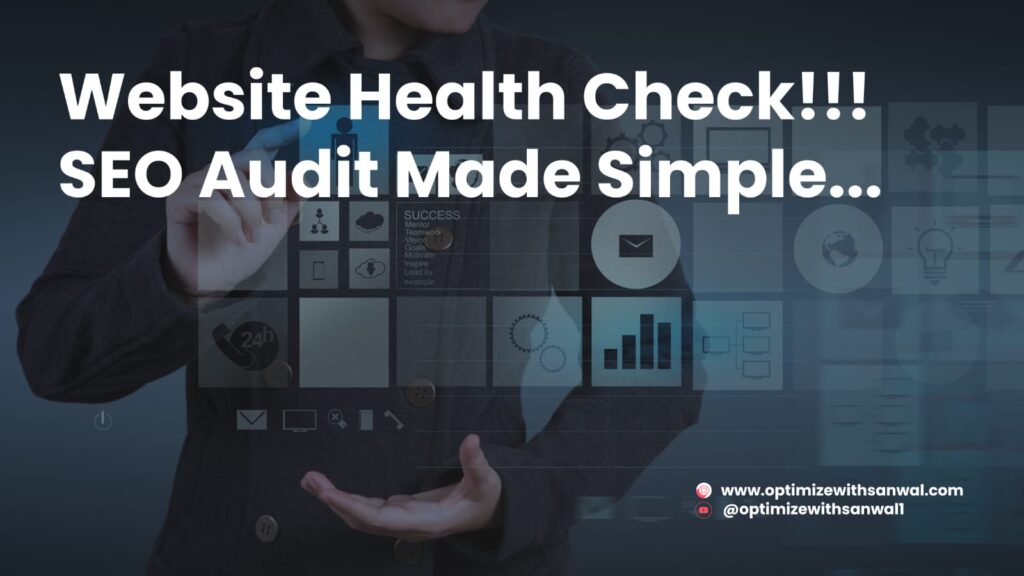SEO Tech Audit Checklist: A Complete Guide
Introduction
Every website needs a regular health check, and in SEO this process is known as a Technical SEO Audit. Without it, you risk losing visibility in search engines, frustrating users with poor site performance, and missing out on valuable traffic. At Optimize with Sanwal, we’ve seen businesses go from being almost invisible to highly discoverable simply by applying a structured SEO audit process. In this blog, I’ll walk you through a step-by-step SEO Tech Audit Checklist that is detailed, practical, and built for the future.
What is an SEO Tech Audit?
An SEO Tech Audit is the process of reviewing your website’s technical foundation to ensure it is search engine friendly. Unlike a content audit that focuses on keywords and articles, a technical audit digs deeper. It examines whether search engines can crawl your site properly, whether your pages are being indexed correctly, how fast your site loads, and whether errors like broken links or poor redirects are harming your visibility. In simple terms, if your website were a house, the technical audit would be the check of its structure, wiring, and foundation.
Why You Need a Website SEO Audit Checklist
Google continues to update its search systems regularly, and without a proper Website SEO Audit Checklist, you can easily overlook issues that impact performance. Having a checklist helps you catch technical errors early before they cause ranking drops, improve user experience by ensuring faster load times, and boost your search visibility by aligning with Google’s latest guidelines. More importantly, it saves resources by keeping your efforts focused on the highest-impact fixes. Think of this checklist as a roadmap—when you follow clear directions, you don’t get lost.
Core Elements of an SEO Tech Audit Checklist
The first area of focus is crawlability and indexation. Search engines must be able to access and index your site properly. That means checking your robots.txt file, ensuring your XML sitemap is updated in Google Search Console, and resolving crawl errors such as broken pages or blocked resources.
The second element is site speed and Core Web Vitals. A fast website not only ranks better but also keeps visitors engaged. This requires optimizing images, reducing heavy code by minifying CSS and JavaScript, and using a Content Delivery Network. Monitoring Core Web Vitals such as Largest Contentful Paint, First Input Delay, and Cumulative Layout Shift helps you understand how users experience your site in real time.
Mobile optimization is the third key factor. Since Google uses mobile-first indexing, you must ensure that your design is responsive, that your site passes Google’s Mobile-Friendly Test, and that menus, buttons, and forms are easy to use on smaller screens. Avoiding intrusive pop-ups is also part of improving the user journey.
On-page SEO elements should not be ignored in a technical audit. Title tags must be clear, unique, and concise. Meta descriptions need to be persuasive and within the right length. Headings should follow a logical structure and align with your main topics. Strong internal linking also ensures smoother navigation and spreads authority across your pages.
The next part is technical health and security. Search engines value safe, error-free sites. This means making sure HTTPS is properly installed, broken links are fixed, canonical tags are correctly set, and redirect chains are not slowing your site down.
Finally, structured data and schema markup help search engines understand your site better. Adding schema for articles, products, FAQs, or events improves how your content is displayed in search results. Validating this setup with Google’s Rich Results Test ensures everything is functioning as intended.
Step-by-Step Website SEO Audit Checklist
When performing an SEO audit, a practical step-by-step approach works best. Start by crawling your site with tools like Screaming Frog or Sitebulb to get a full overview. Check indexation status in Google Search Console to ensure the right pages are visible. Analyze your site speed with PageSpeed Insights and test your mobile performance using Google’s tools. From there, fix technical errors such as broken links, redirects, and duplicate tags. Evaluate on-page SEO elements like titles, meta tags, and heading structures, and make sure your structured data is valid. It’s also important to review your backlink profile for toxic domains and monitor analytics to spot any sudden drops in traffic.
Advanced SEO Tech Audit Tactics
Once the basics are in place, advanced tactics can take your audit further. A log file analysis reveals exactly how Googlebot crawls your site. Crawl budget optimization helps you guide bots toward your most valuable pages. If you’re running international websites, checking hreflang tags is essential to serve the right content to the right audience. Structured data can also be expanded for voice and AI search readiness, which is quickly becoming a ranking factor.
Tools for SEO Tech Audits
There are several reliable tools that make SEO audits easier. Google Search Console is essential for monitoring crawl and indexation issues. Ahrefs and SEMrush provide powerful insights into backlinks and competitive performance. Screaming Frog allows deep crawling of your site, while GTMetrix and PageSpeed Insights provide performance benchmarks. Sitebulb is another excellent option for visual site audits with in-depth reporting.
Common Mistakes to Avoid
Many businesses fail in SEO audits because they overlook common issues. Ignoring mobile-first requirements, forgetting to fix duplicate content, or only running an audit once instead of on a regular schedule can hurt performance. Another mistake is failing to document changes and results, which makes it hard to measure progress or learn from past fixes.
Future of SEO Tech Audits
SEO audits are evolving quickly with AI and automation. Expect more AI-powered audits that identify issues instantly, automated monitoring tools that send real-time alerts, and readiness checks for voice and visual search. The future will make audits more efficient, but human judgment and strategy will still remain essential.
Full Blog Guidance for Readers
At Optimize with Sanwal, my approach is simple: start with the basics and fix errors that directly harm visibility. Once that foundation is strong, move gradually into advanced strategies such as structured data and log file insights. Most importantly, repeat audits regularly and treat them as an ongoing part of your SEO cycle. The best strategy is not just fixing issues but learning from each audit to prevent future problems. If you’d like to go deeper,
check out my full blog on “SEO Audit Checklist: Expert Guide to Better Ranking.”
About the Author
Sanwal Zia – SEO Strategist at Optimize with Sanwal
With over 5 years of SEO strategy experience, I’ve helped businesses grow with structured audits, data-driven strategies, and technical improvements that deliver real results.
📘 Free Resource: Download my SEO Ebook — available now on Optimize with Sanwal’s website.
🔗 Connect with me:
- YouTube: Visit our youtube channel
- LinkedIn: Connect with Me
- Facebook: Add with Me
- Instagram: Add & Check our strategies
Conclusion
An SEO Tech Audit Checklist is not optional—it is essential. By combining crawlability, speed, security, mobile optimization, and structured data, you ensure that your site not only ranks well but also engages visitors and drives conversions. At Optimize with Sanwal, my goal is to simplify complex SEO processes into practical steps that anyone can follow. When you make audits a regular part of your strategy, you build stronger visibility, smoother user experiences, and long-term growth.

